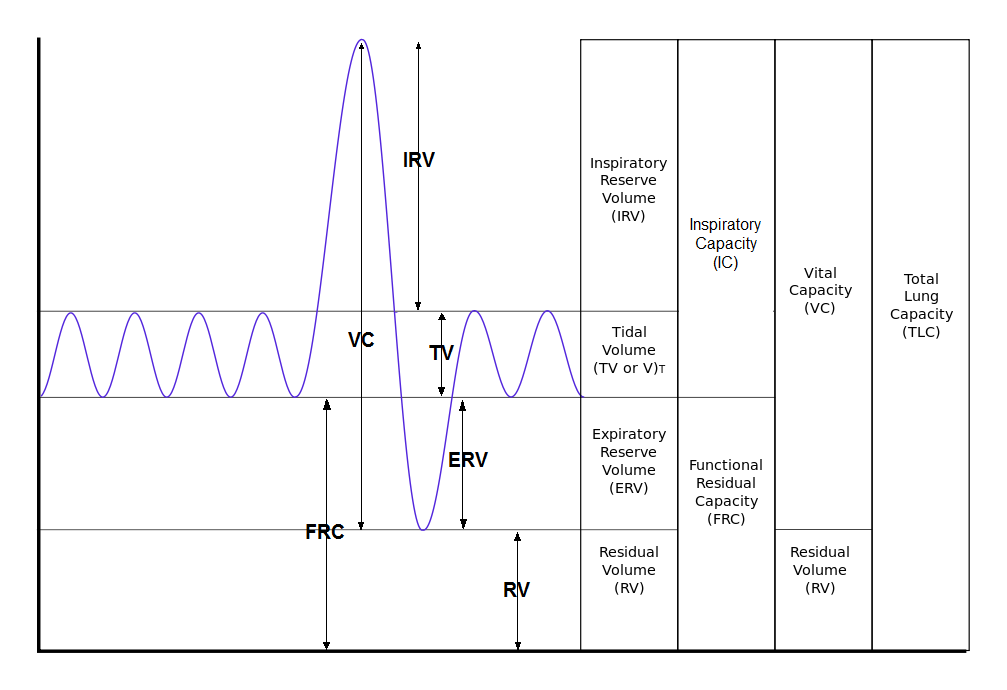
Physiology
Respiratory
Which of the following best describes the functional residual capacity (FRC):
Answer:
The functional residual capacity (FRC) is the volume of air remaining in the lungs at the end of a resting expiration.Lung Volumes
Physiology / Respiratory / Lung Volumes and Pressures
Last Updated: 29th July 2024

Lung Volumes. (Image by Vihsadas at en.wikipedia derivative work: rscottweekly (LungVolume.jpg) [CC BY-SA 3.0 , from Wikimedia Commons)
Volumes
The tidal volume (TV) is the volume of air drawn into and out of the lungs during normal breathing, i.e. the volume change of the lung between a resting inspiration and a resting expiration.
The inspiratory reserve volume (IRV) is the volume of air that can be inspired at the end of a normal inspiration, i.e. the difference in volume between a resting and maximum inspiration.
The expiratory reserve volume (ERV) is the volume of air that can be expelled at the end of a normal expiration, i.e. the difference in volume between a resting and maximum expiration.
The residual volume (RV) is the volume of air remaining in the lungs after a maximal expiration.
Capacities
The vital capacity (VC) is the maximum tidal volume when an individual breathes in and out as far as possible i.e. the volume change of the lung between a maximum inspiration and a maximum expiration.
VC = IRV + TV + ERV.
The inspiratory capacity (IC) is the volume of air that can be breathed in by a maximum inspiration at the end of a resting expiration.
IC = TV + IRV.
The functional residual capacity (FRC) is the volume of air remaining in the lungs at the end of a resting expiration.
FRC = ERV + RV.
The total lung capacity (TLC) is the volume of air in the lungs after a maximum inspiration.
TLC = VC + RV.
Measuring Lung Volumes and Capacities
Lung volumes vary with age, sex and height.
Most lung volumes (except RV) can be measured directly using spirometry.
Residual volume (and thus FRC and TLC) can be measured using helium dilution or body plethysmography.
| Lung Volume | Typical Value (70 kg Male) |
|---|---|
| Tidal volume (TV) | 500 mL |
| Vital capacity (VC) | 5500 mL |
| Inspiratory reserve volume (IRV) | 3300 mL |
| Expiratory reserve volume (ERV) | 1700 mL |
| Total lung capacity (TLC) | 7300 mL |
| Functional residual capacity (FRC) | 3500 mL |
| Residual volume (RV) | 1800 mL |
Report A Problem
Is there something wrong with this question? Let us know and we’ll fix it as soon as possible.
Loading Form...
- Biochemistry
- Blood Gases
- Haematology
| Biochemistry | Normal Value |
|---|---|
| Sodium | 135 – 145 mmol/l |
| Potassium | 3.0 – 4.5 mmol/l |
| Urea | 2.5 – 7.5 mmol/l |
| Glucose | 3.5 – 5.0 mmol/l |
| Creatinine | 35 – 135 μmol/l |
| Alanine Aminotransferase (ALT) | 5 – 35 U/l |
| Gamma-glutamyl Transferase (GGT) | < 65 U/l |
| Alkaline Phosphatase (ALP) | 30 – 135 U/l |
| Aspartate Aminotransferase (AST) | < 40 U/l |
| Total Protein | 60 – 80 g/l |
| Albumin | 35 – 50 g/l |
| Globulin | 2.4 – 3.5 g/dl |
| Amylase | < 70 U/l |
| Total Bilirubin | 3 – 17 μmol/l |
| Calcium | 2.1 – 2.5 mmol/l |
| Chloride | 95 – 105 mmol/l |
| Phosphate | 0.8 – 1.4 mmol/l |
| Haematology | Normal Value |
|---|---|
| Haemoglobin | 11.5 – 16.6 g/dl |
| White Blood Cells | 4.0 – 11.0 x 109/l |
| Platelets | 150 – 450 x 109/l |
| MCV | 80 – 96 fl |
| MCHC | 32 – 36 g/dl |
| Neutrophils | 2.0 – 7.5 x 109/l |
| Lymphocytes | 1.5 – 4.0 x 109/l |
| Monocytes | 0.3 – 1.0 x 109/l |
| Eosinophils | 0.1 – 0.5 x 109/l |
| Basophils | < 0.2 x 109/l |
| Reticulocytes | < 2% |
| Haematocrit | 0.35 – 0.49 |
| Red Cell Distribution Width | 11 – 15% |
| Blood Gases | Normal Value |
|---|---|
| pH | 7.35 – 7.45 |
| pO2 | 11 – 14 kPa |
| pCO2 | 4.5 – 6.0 kPa |
| Base Excess | -2 – +2 mmol/l |
| Bicarbonate | 24 – 30 mmol/l |
| Lactate | < 2 mmol/l |

